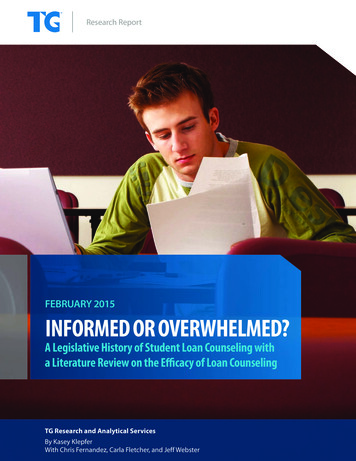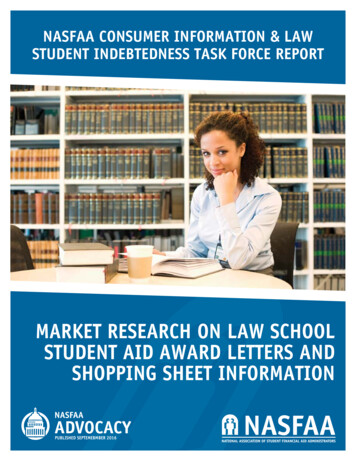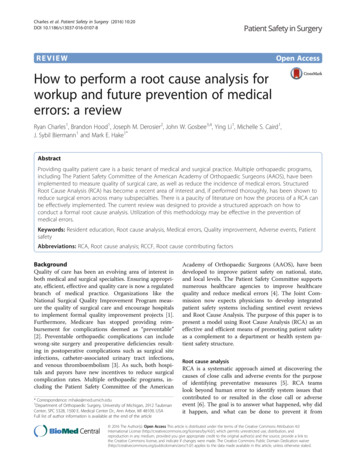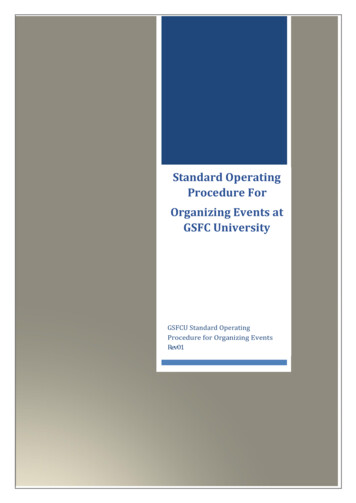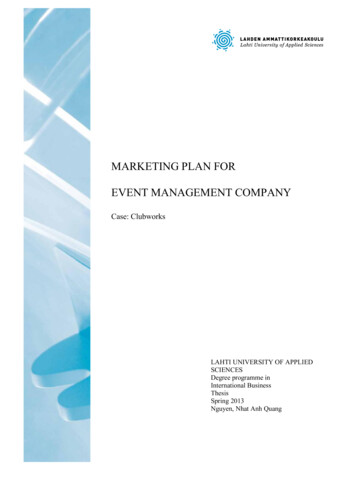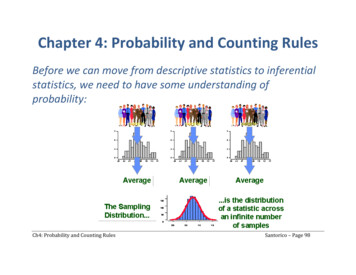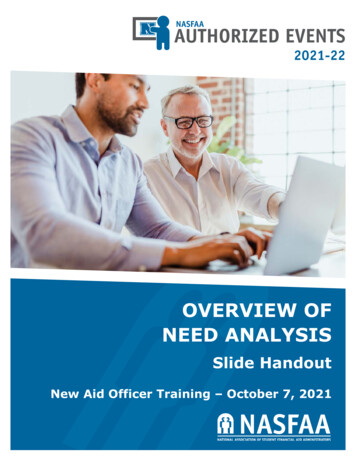
Transcription
AUTHORIZED EVENTS2021-22OVERVIEW OFNEED ANALYSISSlide HandoutNew Aid Officer Training – October 7, 2021
2010-2021 by National Association of Student Financial Aid Administrators (NASFAA). All rights reserved.NASFAA has prepared this document for use only by personnel, licensees, and members. The information contained herein is protected by copyright.No part of this document may be reproduced, translated, or transmitted in any form or by any means, electronically or mechanically, without prior writtenpermission from NASFAA.NASFAA SHALL NOT BE LIABLE FOR TECHNICAL OR EDITORIAL ERRORS OR OMISSIONS CONTAINED HEREIN; NOR FOR INCIDENTAL ORCONSEQUENTIAL DAMAGES RESULTING FROM THE FURNISHING, PERFORMANCE, OR USE OF THIS MATERIAL.This publication contains material related to the federal student aid programs under Title IV of the Higher Education Act and/or Title VII or Title VIII of thePublic Health Service Act. While we believe that the information contained herein is accurate and factual, this publication has not been reviewed orapproved by the U.S. Department of Education, the Department of Health and Human Services, or the Department of the Interior.The Free Application for Federal Student Aid (FAFSA ) is a registered trademark of the U.S. Department of Education.NASFAA reserves the right to revise this document and/or change product features or specifications without advance notice.October 2021
NASFAA Authorized EventOverview of Need AnalysisNew Aid Officer Training – October 7, 2021National Association of StudentFinancial Aid AdministratorsOverview of Need AnalysisA NASFAA Authorized Event*Presented byJackie Cottom, NASFAANew Aid Officer TrainingOctober 7, 2021*For training purposes only; not for credential preparation.Slide 1 2021 NASFAAAgenda Introduction to Need AnalysisThe Regular FormulaSimplified FormulasRecalculating the EFCSlide 2 2021 NASFAAFinancial NeedCost of Attendance (COA)–Expected Family Contribution (EFC) Financial NeedSlide 3 2021 NASFAA 2021 NASFAA1
NASFAA Authorized EventOverview of Need AnalysisNew Aid Officer Training – October 7, 2021Cost of AttendanceTuition and feesRoom and boardBooks and suppliesTransportationMiscellaneous personal expensesSlide 4 2021 NASFAAExpected Family ContributionMeasure of family’sfinancial strength orwealthMeasure of student’sand family’s ability topay postsecondaryexpensesAssess a portion offamily’s availablefinancial resourcesSlide 5 2021 NASFAAUnderlying Principles of Need AnalysisPRIMARYRESPONSIBILITYBASED ON THEFAMILY’S ABILITYTO ZONTALEQUITYSUBJECT TOPROFESSIONALJUDGMENTSlide 6 2021 NASFAA 2021 NASFAA2
NASFAA Authorized EventOverview of Need AnalysisNew Aid Officer Training – October 7, 2021Federal Methodology Uses information provided on the FAFSA Used to calculate nine-month EFC Takes into account dependency statusORSOFTWAREWORKSHEETSlide 7 2021 NASFAARegular FormulaFormula ADependentstudentFormula BFormula )other than aspouseWithdependent(s)other than aspouseORSlide 8 2021 NASFAALearning Activity: Which is the Correct RegularFormula?1. AlexAlex is a 22-year-old senior at Big State University. Heworks part time and earns enough money to pay for mostof his living expenses. Alex’s parents no longer claim himon their tax return, but still pay for his health and carinsurance. Formula A Formula B Formula CSlide 9 2021 NASFAA 2021 NASFAA3
NASFAA Authorized EventOverview of Need AnalysisNew Aid Officer Training – October 7, 2021Learning Activity: Which is the Correct RegularFormula?2. LeilaAt 21, Leila works as the manager of a popular pizzadelivery business and supports herself financially. Heryounger brother Nathan had a huge fight with theirstepfather last year and now lives with Leila. Leila willprovide more than half of Nathan’s financial support duringthe award year and claimed Nathan as a dependent onher 2019 tax return. She plans to enroll at Wood College inFall 2021 to pursue a degree in business. Formula A Formula B Formula CSlide 10 2021 NASFAALearning Activity: Which is the Correct RegularFormula?3. CarlosCarlos is enrolled in the astrophysics doctoral program atNational Science University. He and his wife Maria haveno children, and they now live with her parents becausethe stipend from his research assistantship no longercovers the rent for an apartment close to campus. Formula A Formula B Formula CSlide 11 2021 NASFAARegular tionEFCAssetsSlide 12 2021 NASFAA 2021 NASFAA4
NASFAA Authorized EventOverview of Need AnalysisNew Aid Officer Training – October 7, 2021Allowances Against IncomeStudent’sallowance forparents’negative AAIEmploymentexpenseallowanceU.S. incometaxes paidState andother taxesIncomeprotectionallowanceSocialSecurity taxSlide 13 2021 NASFAAIncome Protection sportationClothing & Personal CareMedical CareOther family consumptionSource: U.S. Department of Education’sApplication & Verification Guide, FederalStudent Aid HandbookSlide 14 2021 ssmentsStudentContributionSlide 15 2021 NASFAA 2021 NASFAA5
NASFAA Authorized EventOverview of Need AnalysisNew Aid Officer Training – October 7, 2021RegularFormulaAParents’ contribution Student contribution from available income Student contribution from assets Expected Family Contribution (9 month)Slide 16 2021 NASFAARegular FormulaFormula AFormula BFormula )other than aspouseWithdependent(s)other than aspouseDependentstudentORSlide 17 2021 NASFAARegularFormulaBStudent(& Spouse)IncomeStudent(& tionEFCSlide 18 2021 NASFAA 2021 NASFAA6
NASFAA Authorized EventOverview of Need AnalysisNew Aid Officer Training – October 7, 2021RegularFormulaCStudent(& Spouse)IncomeStudent(& tionEFCSlide 19 2021 NASFAAAutomatic Zero EFCFormulaAEFC automatically set to zero if parents meet certainfederal tax filing and income criteriaFormulaBNot applicableFormulaCEFC automatically set to zero if student (and spouse, ifmarried) meets certain federal tax filing and income criteriaSlide 20 2021 NASFAAAutomatic Zero EFC: Status CriterionFiled an IRS Form 1040 Filed Schedule 1 only to report:Independentstudent(and spouse,if married)or bothparent(s) ofdependentstudent Unemployment compensation;Alaska Permanent Funds dividends;Educator expense;IRA deductions;Virtual currency; orStudent loan interest deductionsFiled income tax return required for: The Commonwealth of Puerto Rico, Guam,American Samoa, US Virgin Islands, Republicof Marshall Islands, Federated States ofMicronesia, or PalauNot required to file any income tax returnSlide 21 2021 NASFAA 2021 NASFAA7
NASFAA Authorized EventOverview of Need AnalysisNew Aid Officer Training – October 7, 2021Automatic Zero EFC: Status CriterionSupplemental Security Income (SSI)A member oftheindependentstudent’sorparents' ofdependentstudenthouseholdSupplemental Nutrition Assistance Program(SNAP)Free and Reduced Price School LunchTemporary Assistance for Needy Families(TANF)Medicaid (including Children’s HealthInsurance Program)Special Supplemental Nutrition Program forWomen, Infants, & Children (WIC)Slide 22 2021 NASFAAAutomatic Zero EFC: Status CriterionDislocated worker:Independentstudent(and spouse,if married)or bothparent(s) ofdependentstudent Terminated or laid off, could qualify forunemployment compensation, andunlikely to return to a previous occupation Terminated as result of plant closure orsubstantial layoff Employer announced closure within 180days Employer made a general announcementof closure Self-employed, but unemployed due toeconomic conditions or natural disaster Spouse of active-duty service memberunemployed or underemployed Displaced homemakerSlide 23 2021 NASFAAAutomaticZero EFC: Income CriterionPAIndependentRstudent(andE spouse, ifmarried)or parent(s)Nof dependentTstudentSTax FilerAGI 27,000Nontax FilerTotalearnedincome 27,000Slide 24 2021 NASFAA 2021 NASFAA8
NASFAA Authorized EventOverview of Need AnalysisNew Aid Officer Training – October 7, 2021Learning Activity: Who Qualifies for AutomaticZero EFC?1. NicholasNicholas is a dependent student who lives with his mother.He and his mother recently completed the 2021-22FAFSA. Nicholas’ mother works part time as a receptionistfor the local humane society and earned 18,000 in 2019.For the 2019 tax year, Nicholas’ mother filed an IRS Form1040 including a Schedule 1 to report alimony received.Her AGI was 27,000. Eligible Not eligibleSlide 25 2021 NASFAALearning Activity: Who Qualifies for AutomaticZero EFC?2. PriyaPriya is in her second year at Mile High College. She isthe single mother of two small children who live with her.Between her off-campus job and her on-campus FWS job,she earned 20,000 in 2019. She filed an IRS Form 1040with no accompanying schedules for the 2019 tax year.She reported an AGI of 20,000. In 2020, Priya receivedseveral months of benefits through TANF. Eligible Not eligibleSlide 26 2021 NASFAALearning Activity: Who Qualifies for AutomaticZero EFC?3. LupeLupe will be an entering freshman Fall 2021. For 2019,her parents reported an AGI of 48,000 on IRS Form1040. Her father, who works in a local manufacturingplant, just received notice that the plant will be closing inthree months. Eligible Not eligibleSlide 27 2021 NASFAA 2021 NASFAA9
NASFAA Authorized EventOverview of Need AnalysisNew Aid Officer Training – October 7, 2021Simplified Needs TestFormulaAStudent and parent assets ignored if parents meet certainfederal tax filing and income criteriaFormulaBStudent (and spouse, if married) assets ignored if meetscertain federal tax filing and income criteriaFormulaCStudent (and spouse, if married) assets ignored if meetscertain federal tax filing and income criteriaSlide 28 2021 NASFAASimplifiedNeeds Test: Income CriterionPAIndependentRstudent(andE spouse, ifmarried)or parent(s)Nof dependentTstudentSTax FilerAGI 49,999Nontax FilerTotalearnedincome 49,999Slide 29 2021 NASFAARecalculating and Prorating the EFC EFC is:– Distributed proportionately to length ofstudent’s actual enrollment– Prorated for periods other than 9 months Proration of the EFC does not apply to PellGrant or IASG award determinationsSlide 30 2021 NASFAA 2021 NASFAA10
NASFAA Authorized EventOverview of Need AnalysisNew Aid Officer Training – October 7, 2021Recalculating and Prorating the EFC Express periods of enrollment as fullmonths– School may round up or down to full month– Cannot exceed 12-month EFC in a 12-monthperiod Alternate EFC added to the nine-monthEFC could result in double counting thestudent contributionSlide 31 2021 NASFAAAlternate EFC Calculated by CPS Portion of EFC foreach month ofenrollmentPrimaryMon 1Mon 2Mon 3Mon 4Mon 5Mon de 32 2021 NASFAACalculating EFCs for Summer An optional term in many programs School chooses award year from whichstudent will be awarded Packaging depends on whether student willbe enrolled:– Summer only; or– All or part of regular academic year summerSlide 33 2021 NASFAA 2021 NASFAA11
NASFAA Authorized EventOverview of Need AnalysisNew Aid Officer Training – October 7, 2021Agenda Introduction to Need AnalysisThe Regular FormulaSimplified FormulasRecalculating the EFCSlide 34 2021 NASFAASlide 35 2021 NASFAASlide 35 2016 NASFAA 2021 NASFAA12
Get the credit YOU deserve!NASFAA U offers a nationally-recognized, consistent, and rigorous program of education in administering theTitle IV student financial aid programs. Both new and seasoned financial aid professionals will benefit from aNASFAA U education, helping you to become more proficient, more knowledgeable, and more valuable toyour organization —all while working towards earning a NASFAA Credential or NASFAA U Certificate.ONLINE COURSE TOPICS INCLUDE:Fundamentals ofStudent Financial AidCampus-Based ProgramsPackaging and Aid NotificationVerificationCost of AttendanceProfessional JudgmentFederal Pell Grants & Iraqand Afghanistan Service GrantsCash ManagementReturn of Title IV FundsSatisfactory AcademicProgressConsumer InformationStudent EligibilityNeed AnalysisDirect LoansAdministrative CapabilityApplication ProcessingFundamentals ofEnrollment ManagementLearn more about the class schedules, topics covered, and instructorsfor each of our online courses at www.nasfaa.org/Online Courses
The National Associationof Student Financial AidAdministrators (NASFAA)provides professionaldevelopment for financialaid administrators; advocatesfor public policies that increasestudent access and success;serves as a forum on studentfinancial aid issues; and iscommitted to diversitythroughout all activities. 2021 National Association of Student Financial Aid Administrators1801 PENNSYLVANIA AVENUE NW, SUITE 850WASHINGTON, DC 20006202.785.0453 FAX. 202.785.1487WWW.NASFAA.ORG
Student loan interest deductions Filed income tax return required for: The Commonwealth of Puerto Rico, Guam, American Samoa, US Virgin Islands, Republic of Marshall Islands, Federated States of Micronesia, or Palau Not required to file any income tax return Independent student (and spouse, if married) or both parent(s) of dependent student
